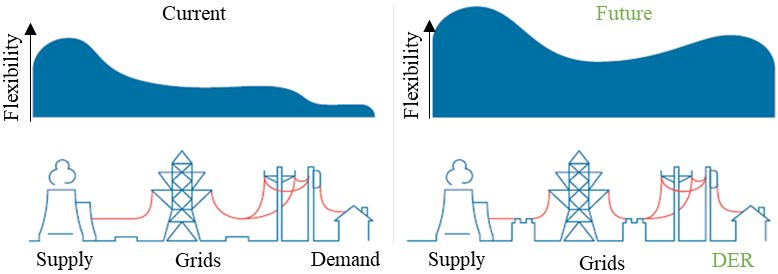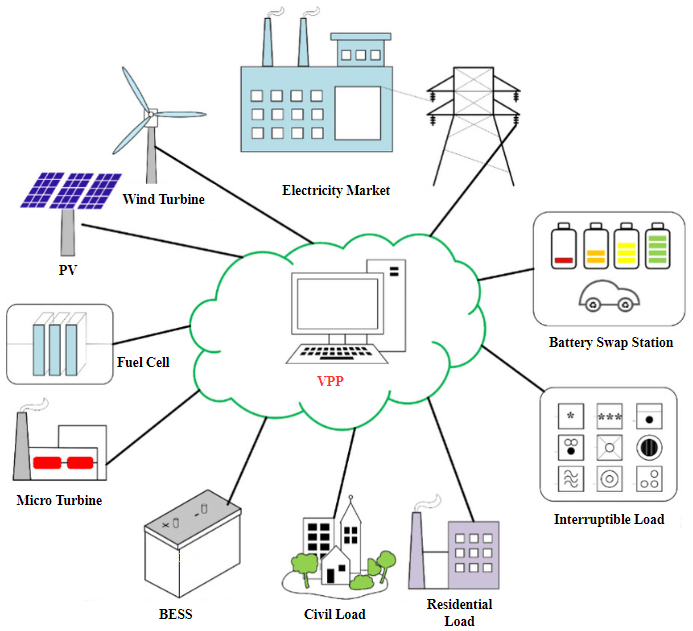Virtual Power Plant (VPP) Technology for a Vertically Integrated Utility
Written by Faisal Sattar and Tareg Ghaoud
Nowadays, the term energy transition is trending worldwide as power systems evolve from centralized non-renewable energy sources to distributed energy resources (DERs). The high penetration of DERs will introduce new challenges to the power system operators because of their lack of visibility, intermittent nature, lack of controllability, and power quality issues that they may introduce to the network. At the same time, the high penetration of DERs will provide a significant amount of flexibility that could be utilized to improve network operations. VPPs aggregate, orchestrate, optimize and control these DERs to offer such unutilized flexibilities to the network. VPPs have been successfully deployed in the deregulated ancillary and energy markets. However, applying VPP technology in a vertically integrated utility could be a challenge. This bulletin aims to discuss the concept of VPP and its application in a vertically integrated utility.
Introduction
In the recent global situation, energy security and climate change are two major issues utilities need to deal with. Due to this, many countries have set very ambitious renewable energy targets to solve the aforementioned issues. For example, Dubai has a plan to achieve 25 and 75 percent renewable sources in the total energy mix by 2030 and 2050, respectively, with PV being the biggest contributor [1]. PV, wind, biomass, hydro, and storage systems are the main renewable energy technologies deployed at transmission and distribution levels to generate and store clean energy. The deployment of a huge amount of DERs in power networks will bring challenges to the operation of the grid. However, it will also introduce a huge amount of flexibility, particularly at the distribution level, as shown in Fig. 1.

Fig. 1 Flexibility in current and future power systems [2].
The problem with the flexibilities available at the distribution level is that it is not visible to the Transmission and Distribution (T&D) operators to be utilized to the full potential for network operations. In the absence of control and visibility of DERs by the T&D operators, new resources would be deployed at the transmission level to mitigate the effect of renewable intermittency for voltage & frequency regulation, generation-demand balance, and power quality improvement. These solutions are not cost-effective as utilities need to invest in new capital-extensive resources instead of utilizing the already existing Behind-The-Meter (BTM) assets owned by the utility’s customers. A virtual power plant (VPP) can be a cost-effective solution to enable the integration of these BTM assets by aggregating such resources and providing visibility and control of these assets providing services to T&D networks.
The Concept of a Virtual Power Plant
The virtual power plant is a digital solution that aggregates, orchestrates, forecasts, optimizes, and controls the flexibility of DERs to support network operations. A VPP mainly consists of virtually connected assets, a digital platform, and a virtually connected utility as shown in Fig. 2. During its operation, the VPP receives an instruction signal from the transmission or distribution system operator, and it dispatches the assets to meet the grid requirements with optimized schedule or instructions.

Fig. 2 VPP basic components [3]
In deregulated energy markets such as the ones in the USA, Australia, China, and Europe, the VPP technology has already been deployed on a large scale. Examples of VPP projects are listed below [4]:
- FENIX: France, UK, and Spain
- Smart WATT: Germany
- EDISION: Denmark and Germany
- Zhanggbai: China
- MOSAIC: USA
- TESLA VPP: Australia
All these projects address the deregulated energy markets where retailers/aggregators can take part in the wholesale energy and ancillary services markets to sell the aggregated flexibilities. In a vertically integrated utility, however, the case is different since there exist no retail or ancillary services markets. Nevertheless, VPP technology is still a valuable enabler in this business setting for the integration of DERs on the distribution network. Therefore, at DEWA R&D, we are conducting a comprehensive study on the value and benefit of the wide deployment of VPP in such a utility business model.
VPP in a Vertically Integrated Utility
In a vertically integrated utility, all the activities from generation, transmission, to distribution are controlled by a single entity where the market is not designed for retailers and aggregators to take part in the generation and grid support services. In such a business setting, the VPP can be utilized to integrate DERs installed in utility-owned sites or sites owned by its customers. The VPP will aggregate and control these DERs to improve network efficiency and reliability. Examples of such assets could be rooftop PVs, Electric Vehicles (EVs), Battery Energy Storage Systems (BESS) utility-scale as well as residential and flexible loads.
The utility may consider regulations and policy changes to incentivize customers to install and participate with their DERs installed at their premises. This is to encourage customers to contribute to the green economy, reduce energy consumption and improve efficiency in the network. However, from the utility perspective, a limitation needs to be considered to manage the power quality, reverse power flow, overloading, voltage violations, and hosting capacity.
Some use cases the VPP may offer to a vertically integrated utility are listed below:
- Peak Shaving
- Demand Response
- Frequency Regulation
- Voltage Regulation
- Congestion Management
- Line Loss Reduction
- Power Quality Improvement
- Load Shifting
- Load-Demand Balancing
- Primary/Secondary Frequency reserve
The above use cases may provide the following services to the utility:
- Forecasting PV generation
- Solar PV management
- Curtailment of excessive PV generation, if needed
- Dispatching DERs e.g. BESS to consume excess power
- Shift EV charging to low load hours
- Implement EV smart charging to enable mobility electrification
- Volt-Var optimization
The benefits harvested by a vertically integrated utility from the VPP technology could include increased system flexibility, improved DER visibility and controllability, diversifying the generation mix in the network and reducing reliance on centralized generation, improving energy efficiency, and encouraging customer self-consumption.
In our opinion, in a vertically integrated utility, customers may be interested in participating in a VPP scheme for a number of reasons.
Energy bill reduction and increased revenue for developers
Customers would be interested to work together with developers using their PV rooftops to generate a certain percentage of the local demand of these customers. The utility may put policies in place to restrict the amount the PV generation installed at the distribution network. VPP technology will act as an enabler for more participation of customers and their developers for utilities to allow them to contribute more to the energy mix with the condition of generation curtailment when their generation may cause network constrained issues. This may create a winning solution for all stakeholders: customers, developers, and the utility.
Optimized network operation and deferment of the immediate needs of network reinforcement
PVs, EVs, demand response, BESS, and interconnected microgrid stations may all be considered a form of DER. Control strategies of DERs such as EV smart charging/managed charging, charge and discharge of distributed energy storage, Volt/Var control, and optimization of distributed inverters would support optimizing network operations, enhance network efficiency, reduce power losses, and deferring the immediate need for network reinforcement. A vertically integrated utility could develop policies and incentives for customers to participate with their DERs acting as additional resources to the utility to make use of them in the control strategies mentioned above. The customer could be incentivized to participate for a monetized benefit. In addition to this, when the utility implements such improved efficiencies on the network, this would still provide cost benefits to the customer. This would create a win-win situation for the utility and the customer.
Contribution towards the sustainable future and green economy
VPP could act as an enabler for customers to contribute more towards sustaining the environment. This would be a strong incentive for customers to share with the community their contribution to the green economy.
Conclusion
With the increased penetration of DERs, it is becoming more challenging to operate the network. VPP is a well-established technology to support T&D system operators to keep the grid in stable operating conditions. VPP has been mainly used by aggregators and retail companies for utilities in Europe, the USA, the UK, and Australia, where there exist wholesale and ancillary services markets. VPP, however, would still provide many benefits to forward-thinking vertically integrated utilities that encourage the integration of DERs on their network. VPP will provide the means to monitor individual assets, aggregate them, and control them to make their network more efficient and reliable. However, utilities need to encourage customer engagement in this process by designing the mechanisms to incentivize these customers to participate in the services provided by the VPP using their DERs.
References
- A. Mnatsakanyan, C. Iraklis, A. Al Marzooqi, and H. AlBeshr, "Virtual Power Plant Integration Into a Vertically Integrated Utility: A Case Study," in 2021 IEEE 12th International Symposium on Power Electronics for Distributed Generation Systems (PEDG), 2021: IEEE, pp. 1-5.
- E. Taibi et al., "Power system flexibility for the energy transition: Part 1, Overview for policy makers," 2018.
- H. Bai, S. Miao, X. Ran, and C. Ye, "Optimal dispatch strategy of a virtual power plant containing battery switch stations in a unified electricity market," Energies, vol. 8, no. 3, pp. 2268-2289, 2015.
- J. F. Venegas-Zarama, J. I. Muñoz-Hernandez, L. Baringo, P. Diaz-Cachinero, and I. De Domingo-Mondejar, "A Review of the Evolution and Main Roles of Virtual Power Plants as Key Stakeholders in Power Systems," IEEE Access, 2022.
This article was edited by Jorge Martinez.
To view all articles in this issue, please go to August 2022 eBulletin. For a downloadable copy, please visit the IEEE Smart Grid Resource Center.

Faisal Sattar is working as a Research and Development engineer at the DEWA R&D Centre, Dubai, UAE. He received a B.S degree in Electrical Engineering from the University of Engineering & Technology (UET), Lahore, Pakistan in 2017, and an MS degree in Electrical & Computer Engineering from Khalifa University, Abu Dhabi, UAE in 2022. He has been working as Lead Engineer Operations at Sapphire Wind Power Company, Karachi, Pakistan from 2017-20, and research assistant at Advanced Power & Energy Center (APEC), Khalifa University from 2020-21. He was also a part of the Masdar Future Sustainability Leaders Program from 2021-22. His research interests include power system modeling, power system studies, smart grids, renewable energy grid integration, virtual power plant modeling & analysis, and condition monitoring of power systems.

Tareg Ghaoud is leading the Smart grid integration team within the DEWA R&D Centre, DEWA, UAE. He is a utility industry expert with research interest in the integration and adoption of smart grid systems, and data analytics in the power transmission and distribution sectors. Tareg is a Chartered Engineer with over 20 years of industry experience. He worked as a delivery project manager and a R&D product owner for innovative projects serving the UK utility industry. He has intensive experience in the development and delivery of SCADA and automation systems for the power transmission and distribution networks, substation control systems, and the development of digital grid solutions for providing grid analytics, and flexibility solutions such as micro-grids, virtual power plants, and Active Network Management (ANM). Tareg has led international teams of different sizes and capabilities and delivered projects using the V-Model as well as the Agile-Scrum methodology approaches. He completed his studies in the UK and holds a DPhil degree in Engineering Science from the University of Oxford (2002), a MSc degree in Control Systems from the Imperial College of Science, Technology and Medicine (1997), and a BEng degree in Control Engineering from the University of Sussex (1992).
To have the Bulletin delivered monthly to your inbox, join the IEEE Smart Grid Community.
Past Issues
To view archived articles, and issues, which deliver rich insight into the forces shaping the future of the smart grid. Older Bulletins (formerly eNewsletter) can be found here. To download full issues, visit the publications section of the IEEE Smart Grid Resource Center.




